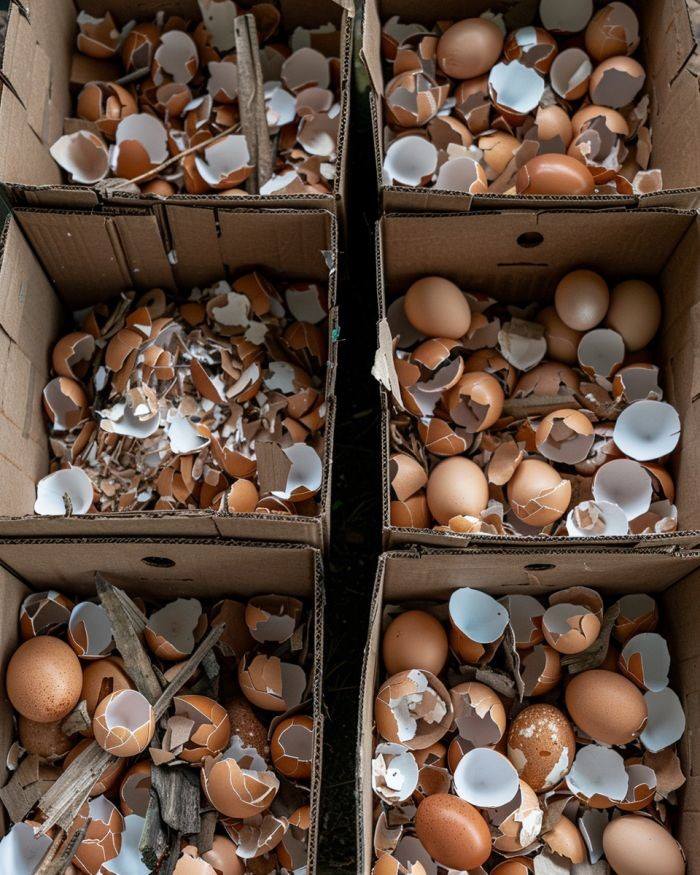ADVERTISEMENT
**How to do it:**
– Collect the eggshells as usual, rinse them to remove any residual egg, and crush them up to help speed up the breakdown process.
– Add the crushed eggshells to your compost pile along with your other composting materials. Eggshells don’t break down quickly on their own, so mixing them with the compost helps integrate them into the pile more effectively.
– Over time, they’ll add valuable nutrients to your compost, which will be absorbed by your plants when you use the finished compost in your garden beds.
#### 3. **Make Eggshell Tea for Liquid Fertilizer**
Eggshell tea is a liquid fertilizer that’s made by steeping eggshells in water. It’s an easy and effective way to deliver nutrients directly to the roots of your plants.
**How to do it:**
– Boil a pot of water, and then add about 5 to 10 eggshells to it.
– Let the eggshells steep in the boiling water for about 10 to 15 minutes. Then, remove the eggshells and let the liquid cool.
– Once cooled, you can use the eggshell tea to water your plants, delivering calcium directly to the soil and promoting strong, healthy growth.
#### 4. **Use Eggshells to Deter Pests**
While eggshells aren’t technically a fertilizer, they can help protect your plants from pests. Crushed eggshells can act as a natural barrier to keep slugs, snails, and other soft-bodied insects away from your plants. The sharp edges of the shells discourage these pests from crawling over them.
**How to do it:**
– Crush the eggshells and scatter them around the perimeter of your garden or around individual plants.
– The coarse texture of the shells will help keep pests at bay, especially in vegetable gardens where slugs and snails are common.
#### 5. **Make Eggshell Fertilizer for Specific Plants**
Certain plants, like **tomatoes**, **peppers**, and **eggplants**, are particularly susceptible to calcium deficiencies, which can lead to conditions like blossom end rot. Eggshells are a great way to prevent this problem by providing a steady source of calcium.
**How to do it:**
– Before planting these crops, dig a small hole at the bottom of each planting site and add a generous handful of crushed eggshells.
– This method will ensure that the plant’s roots have access to calcium from the start, reducing the risk of blossom end rot and encouraging strong, healthy growth.
### Additional Tips for Using Eggshells in Your Garden
– **Use Fresh or Dry Eggshells**: Fresh eggshells will decompose more quickly if crushed and added to compost or soil. However, you can also dry them by placing them in a warm spot or on a baking sheet in the oven at a low temperature (around 200°F or 93°C) to speed up their decomposition if you’re adding them to your garden beds.
– **Balance with Other Fertilizers**: While eggshells are a great source of calcium, they don’t provide all of the necessary nutrients for plants. Consider balancing your eggshell use with other organic fertilizers like compost, fish meal, or blood meal to ensure your plants get a well-rounded nutrient profile.
– **Don’t Overdo It**: Eggshells are slow-release, so you don’t need to add them to your garden beds in excess. A handful or two per plant is usually plenty. Adding too many eggshells can create an imbalance in your soil’s pH or structure.
### The Bottom Line: Eggshells as an Eco-Friendly Fertilizer
Using eggshells as fertilizer is an easy, natural, and sustainable way to enrich your soil and promote healthy plant growth. Whether you crush them, add them to compost, or make eggshell tea, these simple techniques provide your garden with valuable nutrients while reducing waste. So, the next time you make breakfast, save those eggshells and put them to good use — your plants will thank you!
By incorporating eggshells into your gardening routine, you’ll not only help your plants grow stronger but also contribute to a more eco-friendly garden that’s better for the planet. Happy gardening!
